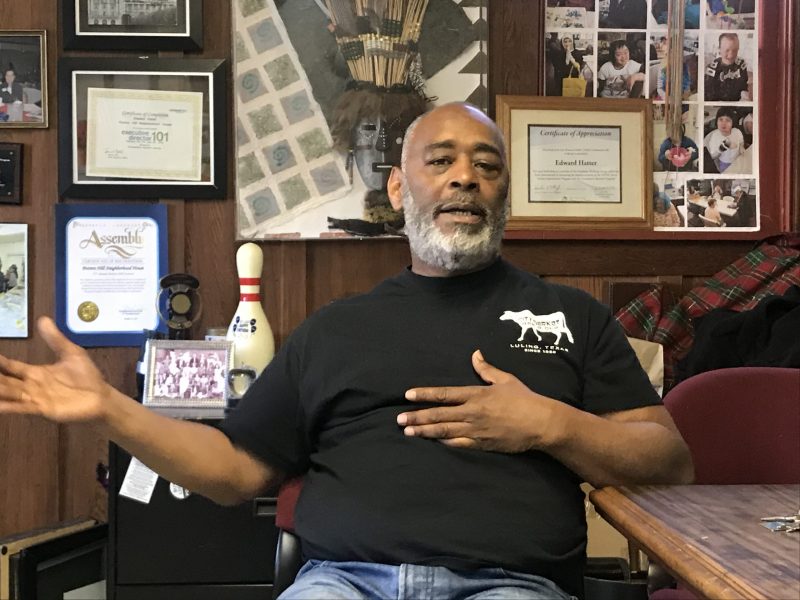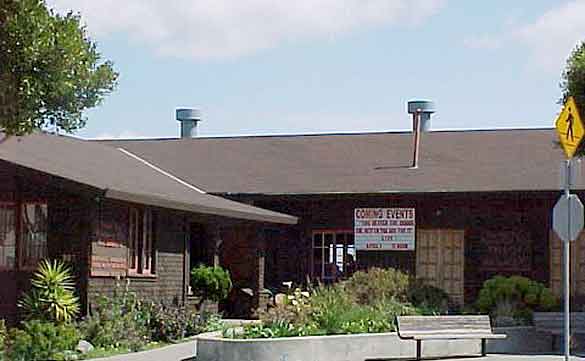Potrero Hill Neighborhood House director in a line of generations looking after community’s wellbeing
Turning 60 is often a time for reflection, a time to consider the next phase of your life. The day after that landmark birthday, Edward Hatter, the longtime neighborhood activist and executive director of the Potrero Hill Neighborhood House, sat in his spacious office and pondered: “I’m still trying to define who’s a senior. I feel 40; am I a senior?”
Hatter has spent the last 16 years running the Neighborhood House, a fixture of San Francisco’s often-overlooked southeast corner. The Nabe, as the community center is often called, has a history stretching back nearly 100 years. He’s steered it through periods of growth and periods of tight money and controversy. Most recently, he’s had to cope with the fallout of the Covid-19 pandemic, which has forced the organization to suspend its most popular programs for seniors and others and blasted a sizable hole in its budget.

Has that made him tired? “Tired, no,” he said. “But it is time for me to think about what’s good for the future of the Neighborhood House – and for me. Maybe a new face would be a good thing. Will I be in this office in a few years? Maybe not. But maybe I will,” he said, grinning and leaning back in his chair.
Whether Hatter stays or goes, the one thing that won’t change, he said, is his commitment to social justice and improving the lives of Potrero Hill residents. “There are still a lot of fights.” His office wall is covered with plaques and certificates attesting to his commitment to the city and the neighborhood, and his online biography lists nearly a dozen commissions and advisory groups he sits on.
Growing up in the ‘hood

Activism, you might say, is in Hatter’s DNA. He’s the grandson of Enola Maxwell, an iconic African-American activist who headed the Neighborhood House for some 40 years, and the nephew of Sophie Maxwell, who represented Potrero Hill and the Bayview on the city’s Board of Supervisors.
Growing up on Potrero Hill and the nearby Bayview, Hatter frequently attended functions at the Nabe. “Grandma brought me, of course, but I really loved the summer excursions to different parts of the city. We were always on the go.” The Nabe still runs a summer camp, but as a result of the pandemic this year’s session won’t include trips around town.
At 60, Hatter is stocky, with a beard that’s going white and a hairline in retreat. On a recent morning, he wore a tight, black tee-shirt from a barbecue restaurant, jeans, and soft slippers to favor two recently broken toes. Hatter was born in San Francisco, but his family moved to Anchorage when he was six. Living in the far North, Hatter said, provided him with some of his first lessons in racism.
When he first arrived, it appeared that people of different races got along really well. But once construction on the Trans-Alaska Pipeline began and workers from the “Lower 48” arrived, the atmosphere changed. Many of those workers, he said, brought racist attitudes with them.
Creeping gentrification
Moving back to San Francisco, where he attended Balboa High School, was “eye-opening.” The atmosphere wasn’t charged, and he met people of many different ethnicities and backgrounds. Hatter finished his education at the University of Alaska and became a construction contractor when he returned to the Bay Area.
An internship at the Nabe sparked his interest in socially conscious organizations, and he became executive director in 2004. His proudest accomplishments? “I’m proud that the building is still open and still serving the neighborhood. And I’m proud that we have made the Potrero Hill Festival so much more inclusive.”
Like much of San Francisco, Potrero Hill has rapidly gentrified in the last decade, but there are still significant numbers of lower-income and elderly residents, many people of color, who are underserved by mass transit, housing, health care and other city services. “We’ve gone through two rounds of gentrification; in the ‘80s and again today,” he says. The neighborhood is sharply divided between the north side, with its million-dollar condos and sweeping views and the south-east corner where aging public housing sits on a hillside.
The center of community
The Neighborhood House provides a wealth of services to the Hill’s population, including meals, a free food pantry and exercise classes for seniors, the summer camp, dance classes, peer counseling for youths in detention, wellness classes, a computer lab and much more.
Founded in 1907, its current home is a 58,000-square-foot brown shingle designed by renowned architect Julia Morgan in the early 1920s. Designated a San Francisco landmark in 1977, It houses meeting rooms, a gym, a kitchen, and a large auditorium with sweeping views of the Bay, the offices of Mission Bay and the East Bay Hills.

Social distancing forced a halt to the popular senior lunch program. As a workaround, the Nabe delivers food to homebound seniors, but that still leaves an important need unfilled. “People come to lunch at 10 in the morning. It’s an important way for them to socialize,” said Hatter.

Exercise classes and most everything else the center normally offers are on hold as well. Renting space in the building for weddings, bar mitzvahs and the like account for about a quarter of the Nabe’s revenues, but Hatter has been able to make ends meet without resorting to staff layoffs, he said.
A reopening – and new programs
The popular youth summer camp resumed in late June and other programs are tentatively scheduled to reopen in August – unless the city suffers a second-wave of Covid-19 infections, Hatter said.
One temporary casualty of the pandemic is a transit-focused program developed by the nonprofit Community Living Campaign. The program would have trained volunteers to become “transit ambassadors” who would have served to educate residents about transit options in the neighborhood and to gather information on transit services needed by Hill dwellers.
“Frankly, public transit on the Hill sucks,” said Hatter. Muni service is relatively infrequent and residents often have a stiff walk to and from bus stops. And since much of Potrero Hill lives up to its name, older residents are often faced with steep walks to the bus.
Hatter said he’s been lobbying Muni for three years, hoping to convince the service to move one bus line about a half block closer to the Caleb G. Clark Potrero Hill Health Center, which sits at the very top of the hill, on Wisconsin Street. Hatter hopes the ambassador program will resume shortly and perhaps be broadened to encompass other needs in addition to transit.
‘So much work left to do’
Housing is another longtime sore point in the neighborhood. While the city has rebuilt some of the dilapidated public housing on the neighborhood’s southern flank, it has created what Hatter calls a “segregation of poverty.” By that he means, the new market-rate housing is physically separated from affordable units. “The poor people are living in kind of a fishbowl for their neighbors to see,” he said.
Working for the Neighborhood House, Hatter said, is “my reason to get up in the morning.” If money were no object, he’d love to expand the Nabe’s childcare programs, and provide more services for “transitional youth,” young people from about 16 to 30, perhaps including housing for them in an expanded Neighborhood House.
Hatter says he’s “hopeful but cautious” that change will come from the recent movement of resistance to systemic racism. But he fears it may come to nothing if there are no concrete plans to implement reforms.
But as much as he loves his work, he’s not at all sure he’d like to see his 23-year-old son follow in his footsteps. Working at a non-profit can be difficult, particularly in a relatively poor community where violence is not uncommon.
Hatter said he is still haunted by the memory of a young man he worked with for years, only to see him paralyzed for life by a senseless act of violence. “There’s just so much work left to do,” he said with a sigh.





